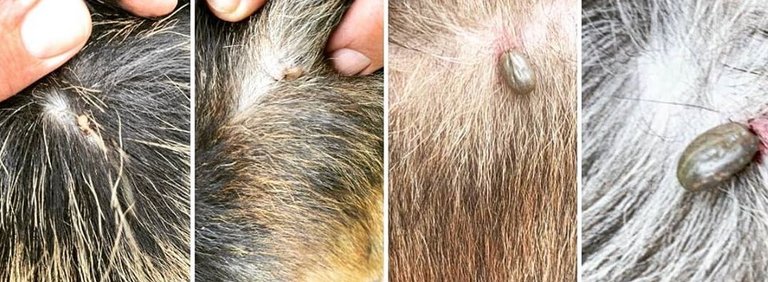Parasites in general are a big problem here in hot, humid Southern Thailand but none are so evident to the naked eye as ticks. They are very easy to spot unlike their microscopic counterparts (mange /fleas / others) and can be removed by hand which is what dogs who have owners might experience. However, for your average street dog, this is not an option.
We have found a very easy to apply and sneakily administer to even the most finnicky of street dogs and so far it seems effective... Oh and it also treats mange and fleas as well! Win / Win

Topical solutions and injections are the most effective, but it can prove quite difficult to administer either of these in the field because our field workers are not veterinarians and are afraid to do it wrong (which is a very reasonable thing to be afraid of since the injection itself can become infected quite easily) and the topical solutions involved the animal standing still for a certain amount of time and also the fact that other dogs will notice the smell and lick the solution off of their backs - there is a reason why it is administered where the dog can't reach it.
The topical solution is actually potentially toxic if consumed so this is no good in the field either.
Ticks are a real pain everywhere in the world but they do seem to absolutely flourish on dogs in Thailand.

They are easy to spot, particularly on dogs that have spent a great deal of time living in wet environments and of course, ticks do jump from dog to dog and breed on the animal itself. Ticks on their own are not necessarily life-threatening, but they are a nuisance to the dogs themselves and for us it is a good indicator that they probably have been exposed to other parasites as well.
Unfortunately most of the solutions that you would use on a pet at home are not viable in the field.
There is a solution that does work and is really easy to administer though.

Bravecto is a type of Fluralaner that is an effective insecticide for all manner of animals that can be administered orally. It also happens to taste like a dog treat so the dogs are easily tricked into eating it when it is mixed in with some daily rations that we put down on the ground. We do have to exercise some oversight because of there are too many dogs there, it could mean that one dog would get more than one dose, so we have to be very careful about this since it is possible to overdose on this drug.
We stand nearby and make certain that the dog that the drug is intended for is the one that gets it and this is normally a pretty straight-forward and easy task. One treatment lasts for 3 months and we are running test trials where we are attempting to treat all of the street dogs in a particular area to see if we can eliminate the tick population altogether by severely limiting which animals it is possible for them to live on.
It would be interesting to see if we can pull this off. When there is a large source of food (the dogs themselves) the ticks thrive and multiply like mad. If we eliminate the food source, the ticks should decrease dramatically in number. Our hope it to achieve precisely that on a small scale and if it is effective, expand the area once we have more resources. It doesn't do us any good to just treat one or two of the pack, we have to get them all, and we have to get them all around the same time.
It is an experiment, but it will be a wonderful one if we can pull it off.
Wish us luck!
If you would like to see how you can help out, or simply spread the word, please visit our website at
http://krabianimalwelfare.org

เป็นผู้สนับสนุนรายเดือนหรือบริจาคครั้งเดียวได้ที่:
my dogs used to get massive ticks on them (well, massive after they were filled with blood) and this was after they were already treated with those gels that go behind their head. I think the kicker here is that it doesn't prevent the ticks from jumping on them, it just makes the dog's blood toxic to the tick so that it will not have a chance to breed on its body, which is a good thing.
to be honest I didn't even know there was an oral anti-tick treatment. This is good to know. We use the collars that are quite expensive but work extremely well. It is easy to understand how this wouldn't be a good option in your operations though. I hope the experiment is a success.